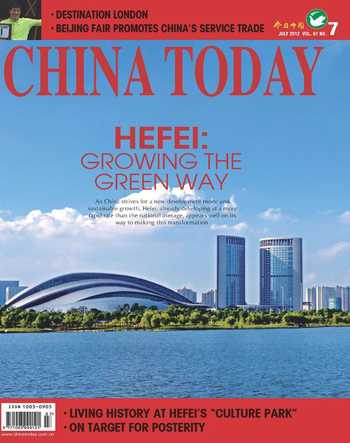Insights into Pub lic Diplomacy from Those in the Know
Although public diplomacy is not a new term in political and academic circles, perhaps it still sounds abstract and alien to members of the lay public. Discussion of it is mostly confined to serious seminars and academic publications.
The Wisdom of Public Diplomacy: Cross-Border Dialogues is presented in the form of dialogues on appealing topics in public diplomacy. The book does away with a lot of jargon, providing a clear window for professionals and lay readers alike to gain a solid grounding in public diplomacy discourse.
The book consists of the dialogues between Zhao Qizheng, now vice chairman of the Foreign Affairs Committee of the Chinese Peoples Political Consultative Conference(CPPCC), and foreign interlocutors: mostly statesmen, senior journalists, scholars and people engaged in public diplomacy, including highly respected names like Henry Kissinger and Richard Lugar.
In 1965, Edmund Gullion, an American career diplomat, first used the term “public diplomacy.”To this day, however, there is no universally accepted definition of the term in the academic world.
In general, public diplomacy is employed by a country to promote its image or reputation in the public of foreign countries. Voice of America (VOA) serves as a classic example of American public diplomacy, and aims to present the countrys values and ideals to the rest of the world.
Public diplomacy is essentially the informal conversation between different cultures. As Zhao Qizheng, the author, puts it: “A lack of such dialogue will inevitably lead to misunderstandings and even conflicts.”
As globalization has left its mark in recent decades, countries have become more interdependent than ever, and when it comes to countries global strategies this has thrust public diplomacy into the limelight.
In 1999, the United States set up a new leadership post, the Under Secretary of State for Public Diplomacy and Public Affairs. In May 2010, Chinas Ministry of Foreign Affairs also established a public diplomacy office.
Although China has been active in public diplomacy in recent times, on the whole it still lags far behind countries like the U.S. in public diplomacy reach and expertise.
The inevitable consequences of inadequate public diplomacy efforts are limited understanding and even distorted perceptions of China overseas. There is a tendency in the country to assume that economic growth guarantees a good national image. This view is misguided, and public diplomacy is essential.
In the dialogues between Zhao and his American interlocutors like Henry Kissinger, former U.S. Secretary of State, Paul Foldi, a senior consultant working in American public diplomacy, and senior reporters and editors from The New York Times, reasons behind some Westerners negative attitudes toward China are discussed in detail. Ideological barriers, Chinas lackluster public diplomacy, the role of media, and different political systems between China and the Western countries were all touched upon.
To present China to the world in an effective and engaging manner, Chinese media should play a vital role. As Zhao points out, however, Chinas newspapers, magazines and media representatives are not good at telling the“China Story.” They get carried away with jargon and clichés, and some outlets fall back on government report-style language instead of adopting a lighter, more amiable tone. This opens a cultural gap – to overseas readers, who are used to a more lively press style, such media conventions seems alien.
There is an unfortunate tendency in many countries to regard “the alien” as “suspicious,” and regrettably, this lazy xenophobia plays itself out where Chinas media is concerned. Too often, Western commentators take the easy way out: Chinese media outlets are mere mouthpieces of the government, they say, and this gives them the excuse they need to reject any and all printed commentary from China.
There are ideological influences on the news in Western countries, the author points out. American reporters tend to look for and focus on conflict, as mentioned by Nicholas D. Kristof, a senior journalist at The New York Times. When conflict is absent, they drudge deeper until they chance upon something, no matter how small, that they can present as conflict. This mentality has affected Americas coverage of China. Zhao emphasizes the role of people-to-people communication in effective public diplomacy.
He divides public diplomacy into traditional and modern schools of thought. Traditional public diplomacy refers to the efforts or investments made by a countys government to influence the public of other countries. In modern public diplomacy, the publics of different countries become active participants. They have easy access to channels for expressing their opinions and can pay closer attention to “how their own countriesinternational reputation influences their personal interests.”
Jim Kolbe, U.S. representative, a former Arizona State Senator, is noted as saying that while the economic, political and even the security relationships between China and the U.S. have deepened dramatically, “I dont think weve seen similar levels of advancement in the area of public diplomacy, i.e., exchanges between peoples of our two nations.”
In many of the books dialogues, the importance of people-to-people and cultural exchanges between different countries is emphasized. After all, public diplomacy is about peoples perception of a country.
China has been actively engaging in public diplomacy activities in recent years, cogently illustrated by the Beijing Olympic Games and the Shanghai World Expo. But there is still a long way to go before its public diplomacy efforts can be regarded as far-reaching, mature and influential.
Alongside his post in the CPPCC, Zhao Qizheng is also dean of the School of Journalism and Communication, Renmin University of China. He has served as vice mayor of Shanghai and minister of the State Council Information Office. His other works include How China Communicates – Public Diplomacy in a Global Age, The China Model –A Dialogue Between East and West and Introducing China to the World– Zhao Qizheng and the Art of Communication.

